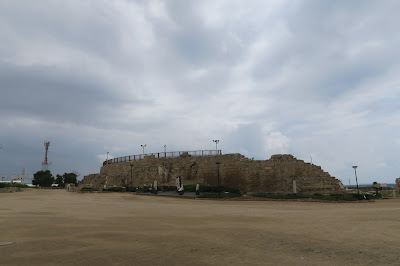Caesarea Maritima meaning "by the sea" was an ancient Roman capital of Judea at the time of Jesus, located on the shore of Israel midway between Telaviv and Haifa. Today Caesarea is an interesting national park and a must-see place when you visit Israel.
Herod the Great built the city of the Caesarea in twelve years. He named the city in honor of Augustus Caesar. It became the capital of the Roman government in Palestine. The Roman procurators, including Pontius Pilate, made their home in Caesarea troops were trained there. The city included an amphitheater, theatre, hippodrome, palace(with swimming pool), drainage system, aqueduct and port. The city was known for its splendor and engineering marvels.
 |
| Back of the amphitheater |
 |
| Ruins of Herod's palace |
 |
| Mighty winds playing with the waves |
 |
| Palace pillars from afar |
 |
| Caesarea shore |
 |
| Kytin, Michelle and Grace |
 |
| One of the oldest functional amphitheater in Israel |
 |
| Entrance to the amphitheater |
 |
| Aerial view courtesy of Wikipedia |
Philip, one of the seven deacons of Jerusalem, settled in Caesarea after ministering in Samaria and to the Ethiopian court official. He had four daughters who prophesied (Acts 6:5; 8:5-40;
21:8-9). Peter came to Caesarea from Joppa and preached the gospel in the home of Cornelius. The coming of the Holy Spirit upon the Gentiles showed that the Gospel was now open to them as well as the Jews (Acts 10).
God killed Herod Agrippa I in Caesarea because he accepted the worship of others(
Acts 12:19-24). Paul visited Caesarea three times: as a young believer and at the conclusion of both his second and third missionary journeys. The third time he stayed at the home of Philip. Agabus, from Jerusalem, came and warned Paul that if he went to Jerusalem he would be captured and turned over the Gentiles(Acts 18:22;
21:6-15). During the two years that Paul was imprisoned in Caesarea, he defended himself before Felix and Festus(Roman procurators) and before King Agrippa II (
Acts 23:23-27:1)













Comments